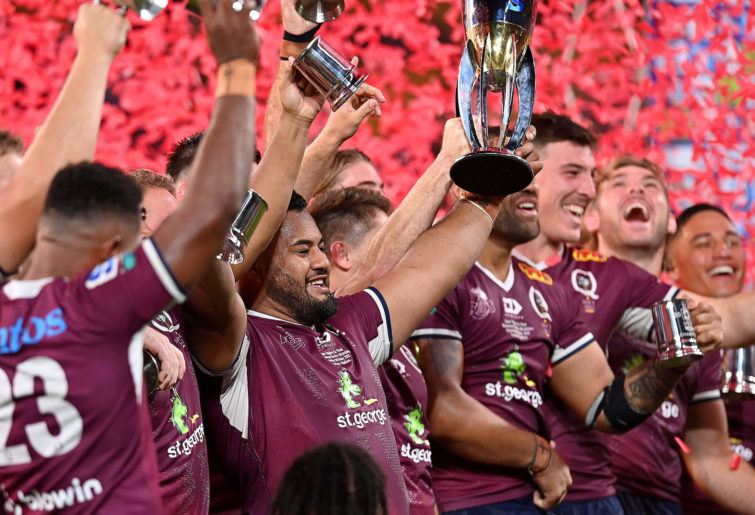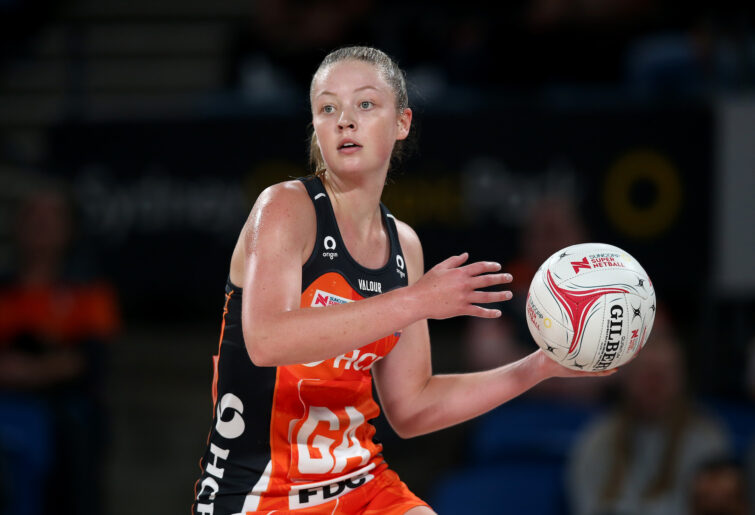In a week where scabs were picked off barely healed trans-Tasman wounds and Rugby Australia made waves about turning their back on Super Rugby, the Crusaders once again showed where the high-level rugby focus should be, no matter where people come from.
Some people believe Super Rugby lacks lustre because the same team keeps winning; the Crusaders’ 21-7 triumph over the Blues is their 11th Super Rugby title, to go with 2021 and 2020’s Super Rugby Aotearoa wins. But surely there is only one lesson to take from this: embrace excellence, don’t turn your back on it.
Despite slippery conditions both sides came to play, although with the Crusaders dictating the tempo of the match from the get go, it was mostly one-way traffic.
Leicester Fainga’anuku and Jack Goodhue combined superbly down the left touchline almost send Codie Taylor in, although the Blues were scrambling well in defence without conceding penalties.
After Richie Mo’unga drilled a drop goal on a free play, the impressive Fainga’anuku almost certainly scored but for Akira Ioane cleverly realising that a defender doesn’t actually need to get under the ball, he just needs to block the camera view of it with his arse.
A match that was humming then had some of the momentum sucked out of it by two TMO interventions which referee Ben O’Keeffe, showing a commendable desire to let things run, waved away.
O’Keeffe won the approval of fans by keeping his cards in his pocket and his eye on the clock, but here was one of rugby’s nagging issues in full view.
In any other match this season, Jack Goodhue’s upright entry into the tackle zone, and head clash with Roger Tuivasa-Sheck, would have earned him a yellow or even red card.

Jack Goodhue. (Photo by Joe Allison/Getty Images)
While there is something appealing about watching a referee trust his feel for the game, it doesn’t seem right to condition players, coaches and fans into following a rigid foul play decision framework, aimed at minimising head contact, only to abandon it in the blink of an eye.
Just before halftime, 6-0 felt like poor value for the Crusaders, but they swept forward again in attack, Mo’unga and Fainga’anuku deadly on the front foot, before Sam Whitelock’s precision clean-out opened up a spot on the chalk for Bryn Hall to force the ball for a 13-0 halftime lead.
Just as nobody predicted a drop goal as the opening score, surely nobody had fingered David Havili as the outstanding performer of the first half. Considered by many to be fortunate to retain selection for the All Blacks, he was not only clever and skilful on the ball, but outstanding in his defensive decision-making, timing and execution.
The Blues, a week before, had launched into the Brumbies with gusto at the breakdown, but here the Crusaders’ cleanout was so ruthlessly efficient they never got a look in.
And with five line-out feeds going belly-up in the first half alone (they would total nine losses by match end), they were simply starved of the possession they needed to bring Rieko Ioane and Mark Telea into the match, and post any meaningful, repeated attacks.
It was more of the same after halftime, until the 56th minute when the match sprung to life; Hoskins Sotutu taking advantage of a lucky rebound, Scott Barrett audaciously stealing the ball back, Dalton Papalii running free like a man no longer burdened by an appendix, before Finlay Christie upset Cullen Grace at the back of a scrum and slithered over, to get things back to 16-7.
The Blues finally had momentum, but they didn’t have a reliable set-piece; their scrum joining their line-out on the scrap heap, their bench a limp handshake on a night where a steely-eyed, firm grip was needed.
These things now become work-ons for next season, albeit this one highly creditable. If the Blues carry the hurt with them and use it to good effect, they have a valuable springboard to success in 2023.
Pablo Matera might have been lucky to have been playing, but he made the most of his good fortune, running strongly throughout, handling deftly, then stabbing a kick through with his left foot for Sevu Reece to follow up and comprehensively seal the title.

(Photo by Kai Schwoerer/Getty Images)
There really isn’t much else left to say about the Crusaders, other than a team which had been slightly off its best for much of the season, delivered once again when it counted, in a ruthless, clinical manner, across all facets of the game.
It’s instructive at this point to consider the final from the viewpoint of two interested onlookers; Ireland coach Andy Farrell and Rugby Australia chairman Hamish McLennan.
In a fortnight’s time, Farrell’s side begins a three-Test series against an All Blacks side that will contain a decent spread of players who featured in the final.
He will have learned nothing he didn’t know already about New Zealand rugby; the All Blacks almost certain to follow the Crusaders’ blended template of moving the ball to both sides of the field, while fronting up physically, while trying to play the game at speed.
He knows it doesn’t really matter which one of Mo’unga or Beauden Barrett starts at 10, because he already understands that the way to nullify that threat is for his pack and rushing backline defence to harry the All Blacks into losing their composure and playing behind the advantage line.
Farrell will also have noted the telling contributions of Whitelock and Scott Barrett, playing all over Josh Goodhue and Tom Robinson, while eyeing an opportunity to exploit Akira Ioane’s lack of dash and forward punch.
He would have come away with a nodding respect for the assured contributions of Sotutu and Stephen Perofeta in a beaten side, while noting how Fainga’anuku’s strength and confidence – if he gets a run – presents an interesting challenge for his three-quarters.
But if we are allowed to speculate – which is all we can do without tapping into another man’s mind – it is likely that Farrell would have been entertained more than he was intimidated. A rollicking series awaits; as it does in Australia with England’s visit.
McLennan’s focus might have been more on the 43,000-strong Eden Park crowd and the return on investment for NZ broadcast rights holder Sky Sports, whose contribution to the revenues of NZ Rugby currently sits at roughly three times what Stan/Nine pays Rugby Australia.

Hamish McLennan’s recent comments raised eyebrows (Photo by Mark Metcalfe/Getty Images)
The Australian-based rugby audience for this final can be roughly broken down into three groups: those who, even if not invited, love a wedding and hang around near the church to cheer the bride and groom regardless; distant relatives or people who come from the same home town who retain a close interest; and the detached, who are only interested in weddings involving their own family, and who found something else to do.
It was the third group of Australian rugby fans who McLennan was playing to this week, raising the possibility that from the 2024 season, Rugby Australia might be prepared to walk away from Super Rugby and place its attention and resources into a domestic competition.
One question worth posing is based around the 2014 Super Rugby final, won by the Waratahs in front of a Super Rugby record attendance of 61,823.
Would the same happen again today if the Waratahs were to host the Super Rugby final? I suspect it would; one of the reasons being because fans will support a winning side that plays attractive rugby, and another reason being its scarcity.
But a rare Super Rugby final win in a cross-nation competition involving New Zealand is not the same thing as a final win against the Brumbies or Reds after already having played them three times in the regular season.

(Photo by Bradley Kanaris/Getty Images)
There will be more to say on this next week, when we examine in more detail the conundrum facing Rugby Australia and why all of the focus and attention dragged back out into the public arena this week, is a classic case of applying the wrong solution to the wrong problem.
In the meantime, it’s useful to consider the plight of Netball Australia, despite being the beneficiary of over $5m of government grants in the last four years, still carrying debt of around $4m, and running at operating deficits of $4.4m for 2021 and $2.8m for 2020.
The standard of Australia’s Super Netball league is uniformly high, and the Diamonds will head to the Birmingham Commonwealth Games as the world ranked No.1 side.
But despite being a hugely popular sport at junior and grassroots level, like rugby, netball struggles for bandwidth in the crowded, AFL and NRL-dominated media space.
Player salaries in elite women’s sports have started to increase and, partly in an effort to head off competition from AFL and other sports, it has been netball that has led the way with groundbreaking salary increases for its top players.
This expense has not been matched on the revenue side. Prior to 2016, a trans-Tasman competition was substantially underwritten by Sky New Zealand, but once Netball Australia turned their back on New Zealand and launched their own competition, Australia’s new broadcasting rights deal generated only around half of the previous revenue.
A day of reckoning is nigh. Netball Australia gratefully accepting a $650,000 offer from the West Australian government to host this year’s grand final was met with howls of protest from the player’s association and fans, decrying it as unfair and out of touch.

Sophie Dwyer of the Giants. (Photo by Jason McCawley/Getty Images)
Like rugby, netball is riven by a federated structure that often pits the parochial interests of largely amateur state bodies against the national administration.
Why is the parlous state of netball in Australia relevant and important?
No matter how dominant or appealing a national team is on the world stage – the Diamonds, the Wallabies, the Silver Ferns or the All Blacks – both netball and rugby operate in a domestic market that is, in commercial terms, small and finite.
Yes, there are important differences between the countries and good reasons why some things can and should always be left to operate for the benefit of each nation’s domestic needs.
But in a global marketplace, if things are handled judiciously, professionally and collaboratively, one plus one can definitely equal three. Both nations have worked effectively and collaboratively to deliver a meaningful and enjoyable Super Rugby competition in extremely challenging circumstances.
There is an opportunity for both nations to finally loosen their hold on Super Rugby and properly resource a more autonomous body that can elevate their competition.
McLennan’s posturing this week may well bring about a reassessment of the broadcasting split, but before he digs a hole too big to climb back out of, he might do well to call Netball Australia CEO Kelly Ryan to get her take on what can happen when a sport turns its back on New Zealand and goes it alone with a domestic professional competition.

































































































